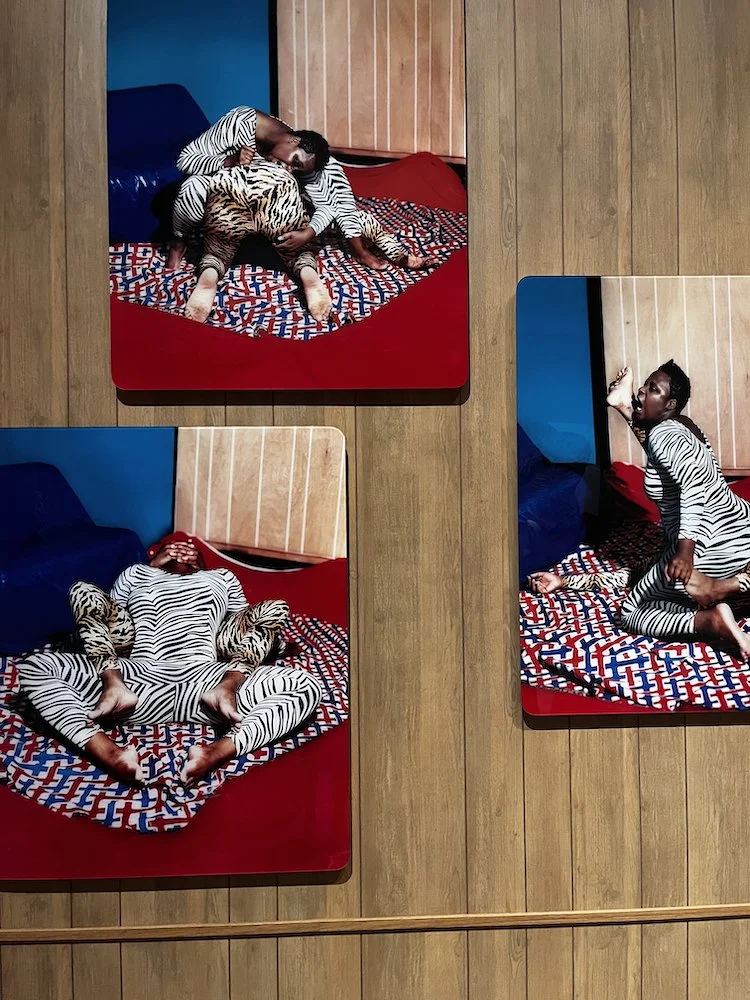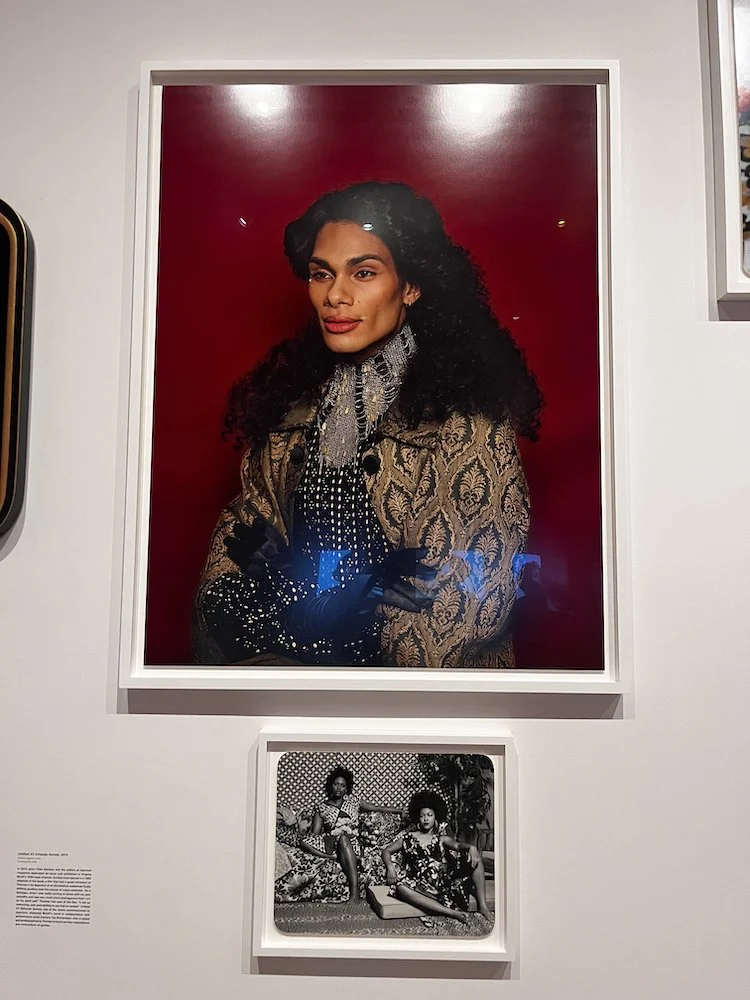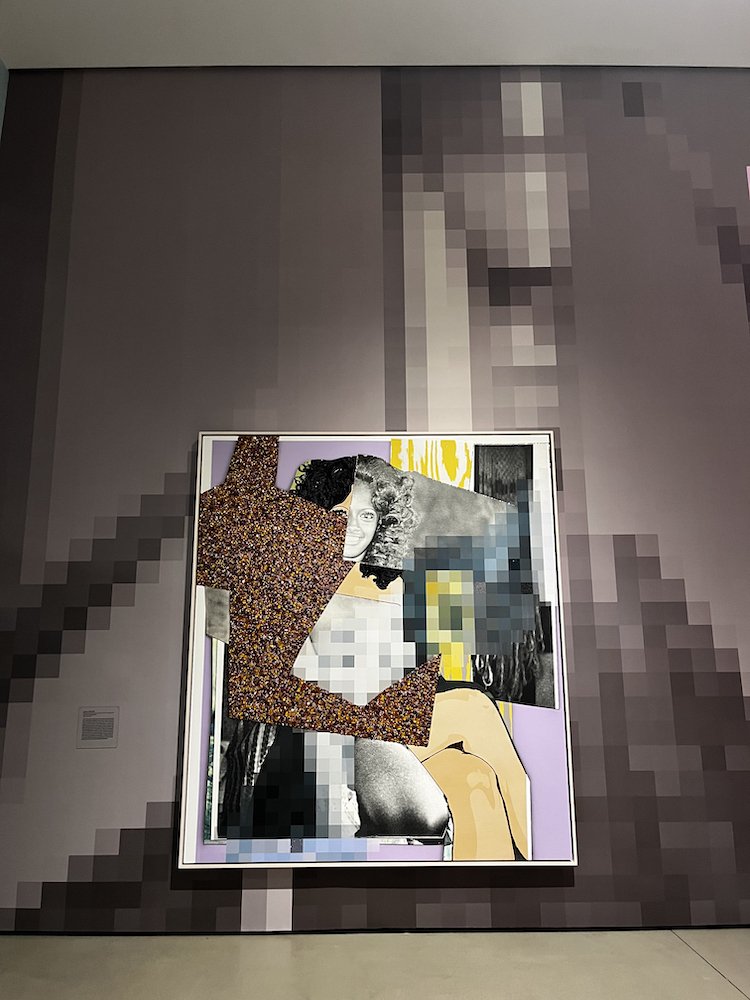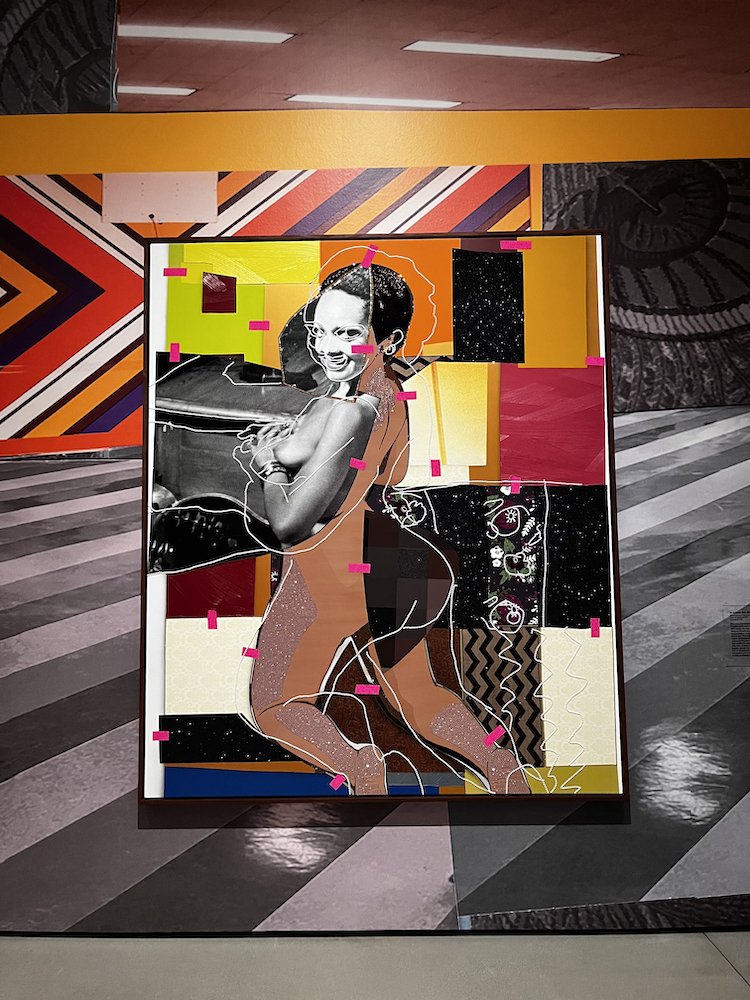Mickalene Thomas’ “All About Love” Is A Spectacular Funhouse for Black Women
“Mickalene Thomas: All About Love,” currently on view at The Broad in Los Angeles, marks the first international tour of the renowned multidisciplinary artist. The exhibition showcases over 90 works created by Thomas over the past two decades, highlighting her mastery and innovation across various disciplines, from collage and photography to installation and mixed-media painting. Drawing its title and many of its themes from All About Love: New Visions, the seminal 1999 book by Black feminist author and theorist bell hooks, the exhibition invites viewers to reconsider love by challenging misconceptions and unrealistic expectations. Hooks delves into its complex nature, emphasizing love’s interconnectedness in our private and public lives, and inspires us to reimagine radical ways of loving that go beyond the conventional notion of romantic love.
In a similar vein, Thomas’ work celebrates her love for friends and family and her admiration for Black women in pop culture—figures whose images have profoundly influenced her perception of self, society, and Black womanhood. Through a lens of love, Thomas’ “All About Love” presents a vast, vibrant depiction of Black women. Her thoughtful inquiries into visual culture, beauty, intimacy, femininity, sexuality, erotica, kinship, politics, care, leisure, rest, and memory encourage viewers of all backgrounds to engage with a politic of love for Black women in their personal, professional, and political lives. However, the exhibition is unapologetically for us, by us—a spectacular, kaleidoscopic funhouse of mirrors, both figurative and literal, where we feel seen in a myriad of moments, lights, and perspectives at every turn.
Hooks asserts in “All About Love” that our ideals of love are established in early childhood. The exhibition begins with a reflection on Thomas’ childhood in Camden, New Jersey, where the building facades at the entrance evoke memories of urban neighborhoods like the one I grew up in Connecticut. The banner reading “I Was Born to Do Great Things” is a powerful affirmation of self-confidence and self-value, a declaration both for Thomas and for viewers, particularly Black women. This theme of affirmation resonates throughout the exhibition, challenging the notion that Black women are arrogant when we uplift, embrace, and celebrate ourselves. This affirmation, implicit and explicit throughout the exhibition, resonated deeply with me because Black women are often considered arrogant and indecent when we talk their shit and hype themselves up.
Thomas and I, along with many other Black women creatives—notably Thomas’ original motivator, acclaimed multidisciplinary Carrie Mae Weems, whose portrait is also in the exhibition—incorporate mirrors and the concept of reflection in our work. In my recent performance art series “Feeling Myself,” I invite Black women and girls in public spaces to affirm, admire, adorn, and celebrate themselves while gazing into a full length mirror. The performance also involves me inviting non-Black women to assist me in self-affirmation and -adoration by holding the mirror as I apply makeup, dance and sing to myself, and more. Similary, Thomas encourages Black women to admire and celebrate themselves, as seen through the mirrors throughout her work—like the literal hand mirror intentionally placed on an end table in the “Tableaux” piece or painted in “Din avec la main dans le miroir et jupe rouge” (2024) (they might be the same mirror), or the large acrylic mirror pieces incorporating the images of legendary Black actresses, models, and classic film characters whom many Black women, Thomas included, have seen themselves in. During their time, these representations served as rare instances of beauty, desire, eroticism, and love.
There are also figurative mirrors, like “Angelitos Negros,” (2016) the video installation that features late actress, singer, and activist Eartha Kitt singing her 1953 song “Angelitos Negros (Black Angels)” alongside three other screens showing Thomas and two of her own muses mirroring Kitt’s appearance and performance. “The mirror is a powerful tool because it forces you to deal with yourself on a deeper level,” Thomas said in a 2012 interview with Modern Painters. “Conceptually, paintings are like mirrors. They’re an expression from the artist: “This is how I view the world—I’m presenting it to you.”
The exhibition is also a masterclass in exploring Black women and eroticism—from our relationship to it, to our perceptions of it, our performances of it, our embracing of it—all through the gaze of a Black queer woman, often on a massive, unapologetic, all-up-in-your-face scale. Some pieces are as tall as eight feet, a rarity in historically white-major art institutions or even many Black art spaces (not that we, as Black people, don’t often showcase Black women’s eroticism, but I’m thinking of solo exhibitions where multiple instances of Black women’s nudity celebrate sexual pleasure, leisure, and autonomy, as opposed to the sexual violence, trauma, objectification, and subjugation that have dominated much of the discourse and narratives of Black women’s sexual experiences and representations).
One piece that comes to mind is “Madame Mama Bush” (2006), a portrait Thomas photographed of her mother, Sandra Bush. Lying on a couch in one of Thomas’ iconic, maximalist sets, Bush is seen luxuriating, her skin absolutely glowing, radiating and posing like a carefree goddess, akin to Titian’s “Venus of Urbino” (1538)—but through Thomas’ empowering gaze. With one arm reaching back to cradle her head, her breast spilling out of her ruby unbuttoned blouse, Bush exudes confidence and comfort. The description explains that during the session, Thomas instinctively reached out to cover her mother’s chest, only for Bush to stop her, letting her daughter know that she wanted to be photographed that way. This exchange was a light bulb moment for the artist in terms of representations of nude women, marking “a moment of permission and acceptance for Thomas.”
Another excellent feature of this exhibition is its retrospective nature. We see “Madame Mama Bush,” an “Aha!” moment in Thomas’ representations of nude women, and later in the exhibit, we encounter the Jet series, which Thomas began in 2017—more than a decade later—where she sourced Jet’s nude calendar to unapologetically celebrate Black women.
“I think there’s something to owning Black women’s erotica—us owning our sexuality needs to be validated as we own and love our own bodies, and want to be desired,” reads the description at the entrance to Jet. “The Black female body is beautiful.”
As someone who has always embraced my sexuality from an early age—through both social and artistic performance and presentation—this series resonated with me. Being a Black woman grappling with Black feminist theories and inclinations while also being brought up in, participating in, and supporting many representations of Black women’s sexuality—especially in popular culture—means living in a constant state of contradiction. It’s a particular gray area that often feels hypocritical and counterproductive in a way that perpetuates much of the aforementioned sexual violence, trauma, subjugation, and oppression disproportionately experienced by Black women in the U.S. and globally.
But while walking through the Jet section, absorbing the large pieces that depicted anonymous Black nude calendar models in all their unabashed glory, I felt offered an alternative to this tumultuous internal tug-of-war. Thomas deconstructed the original images, applying her signature collage style in a way that stripped away hypersexual objectification while retaining sexiness, seduction, raciness, and playfulness. Her maximalist approach, along with abstraction techniques, reconsiders the censorship of the calendar models—a woman’s nude body was never fully shown, with portions of the model’s image inventively blocked out—as the artist intervenes in each scene with pixels, various prints, graphics, and her meticulously placed glitter and gems.
Thomas’ radical love of self as a Black queer woman plays a critical role throughout the exhibition. To be a queer Black woman is to challenge conventions that defy your existence and humanity, a theme that Thomas' show compellingly embodies through her unwavering commitment to love as a transformative force. The prioritization and recognition of intimacy among Black women—whether romantic, familial, or platonic—have long been foundational to Black feminism, particularly as advocated by Black women writers, artists, educators, and activists. The Combahee River Collective, founded by Barbara Smith, Beverly Smith, and Demita Frazier, is a prime example of this. Black queer feminist analysis has always celebrated the power of communal love and care, emphasizing the importance of protecting and creating spaces of safety and creativity.
Speaking of creating safe spaces, another standout element of the exhibition was the opportunity for literal rest and restoration. The Wrestle room featured shag carpet and several red bean bags, creating a relaxed environment for visitors. Another larger room was outfitted with plush armchairs, footrests, and end tables stacked with foundational books on Black feminism, Black liberation, and Black love. Unlike these interactive areas, the tableaux were not accessible to visitors. This was likely because the tableaux felt like delicate, frozen moments—scenes plucked from Thomas' mind and the collective Black American experience. They highlighted how Black women's home environments are themselves works of art, reflecting self-determination, creativity, beauty, and safety.
However, as fellow multidisciplinary artist Tatyana Fazlalizadeh asserts in her recent show "Finding Soft Ground” (which I reviewed here), violence and terror can also infiltrate our homes, as seen with the tragic cases of Breonna Taylor and Sandra Massey. This is a reality that Thomas would undoubtedly agree with. Similarly to the home-like installations in Thomas and Fazlalizadeh’s shows, elements of Swizz Beatz and Alicia Keys’ ongoing "Giants" exhibition at The Brooklyn Museum and the "Reclaiming My Time" exhibit at the National Museum of African American History and Culture also meditate on the cultural, political, and social significance of rest and restoration for Black people.
The themes of “All About Love” extend beyond the exhibition itself. The Broad collaborated with Thomas to offer a series of programs, including a summer concert series. I attended a performance celebrating Black femmes leading contemporary music, featuring METTE, Fousheé, and Flo Milli. While I missed METTE, I saw the latter half of Fousheé’s set, where she showcased her guitar skills and sang about love with a vulnerability that was both refreshing and poignant. Flo Milli also captivated the audience, continuing the tradition of Black women rappers who center self-love in their work. Whether discussing romantic partners, friends, or personal achievements, Flo Milli's lyrics—such as in “Conceited,” “Like That B*tch,” “My Attitude,” and “Big Steppa”—reflect a deep sense of self-worth. In a music industry rife with colorism and misogynoir, it is empowering to hear artists like Flo Milli, JT, and Doechii celebrate their deep complexions and challenge oppressive narratives. Thomas mirrors this approach in “All About Love,” using reinterpretations of 19th-century French paintings—like Henri Matisse and Édouard Manet’s works—to push back against the subjugation and oppressive narratives perpetuated by Western archives and cultural institutions.
In “All About Love,” bell hooks writes that “to truly love, we must learn to mix various ingredients—care, affection, recognition, respect, commitment, and trust, as well as honest and open communication.” Mickalene Thomas’ exhibition is a profound visual manifestation of this philosophy. Through her art, Thomas challenges us to reconsider how we love ourselves, each other, and the world around us, urging us to embrace a more expansive, radical love that centers Black women sisterhood and celebrates our beauty, strength, and resilience.



































































